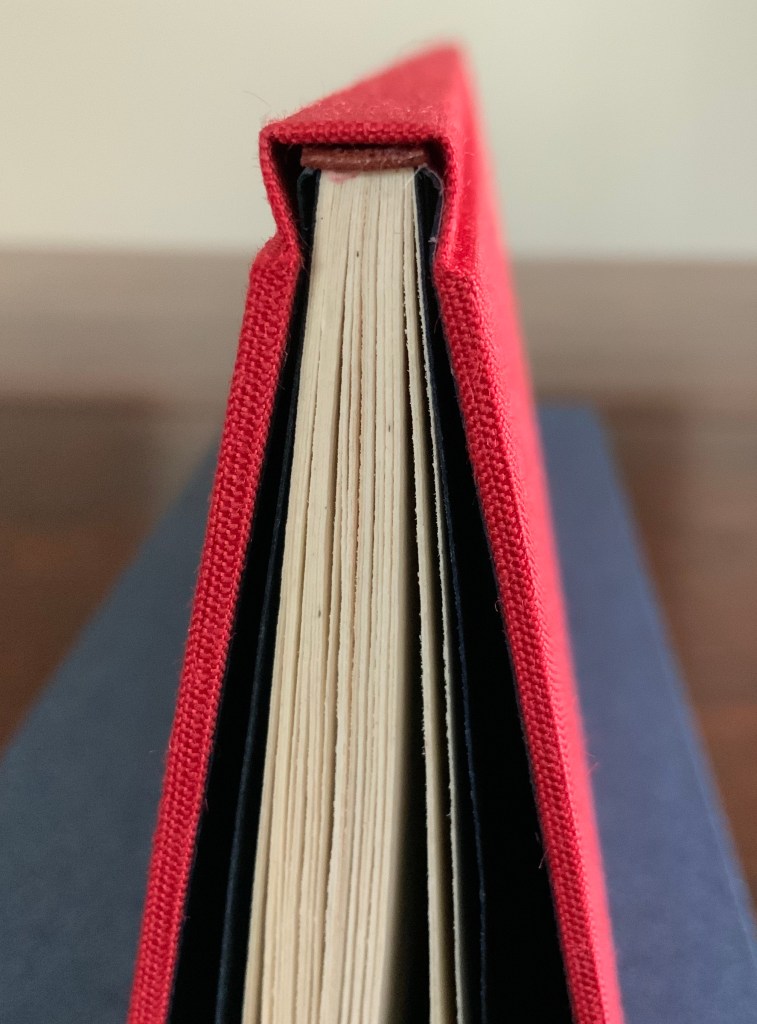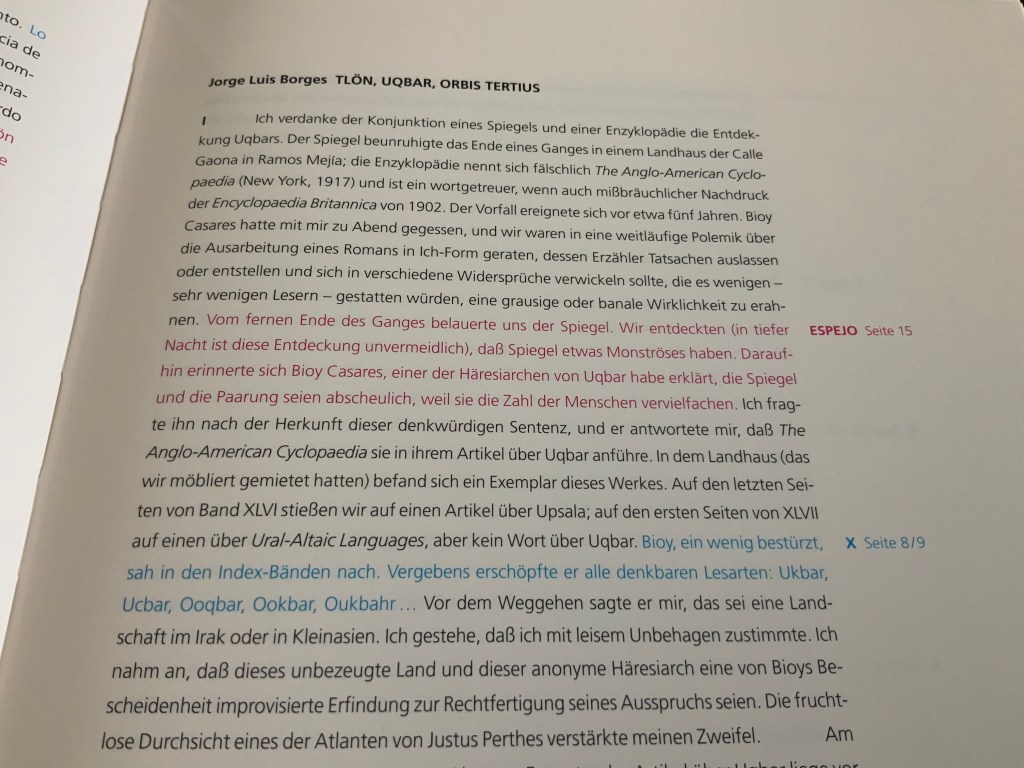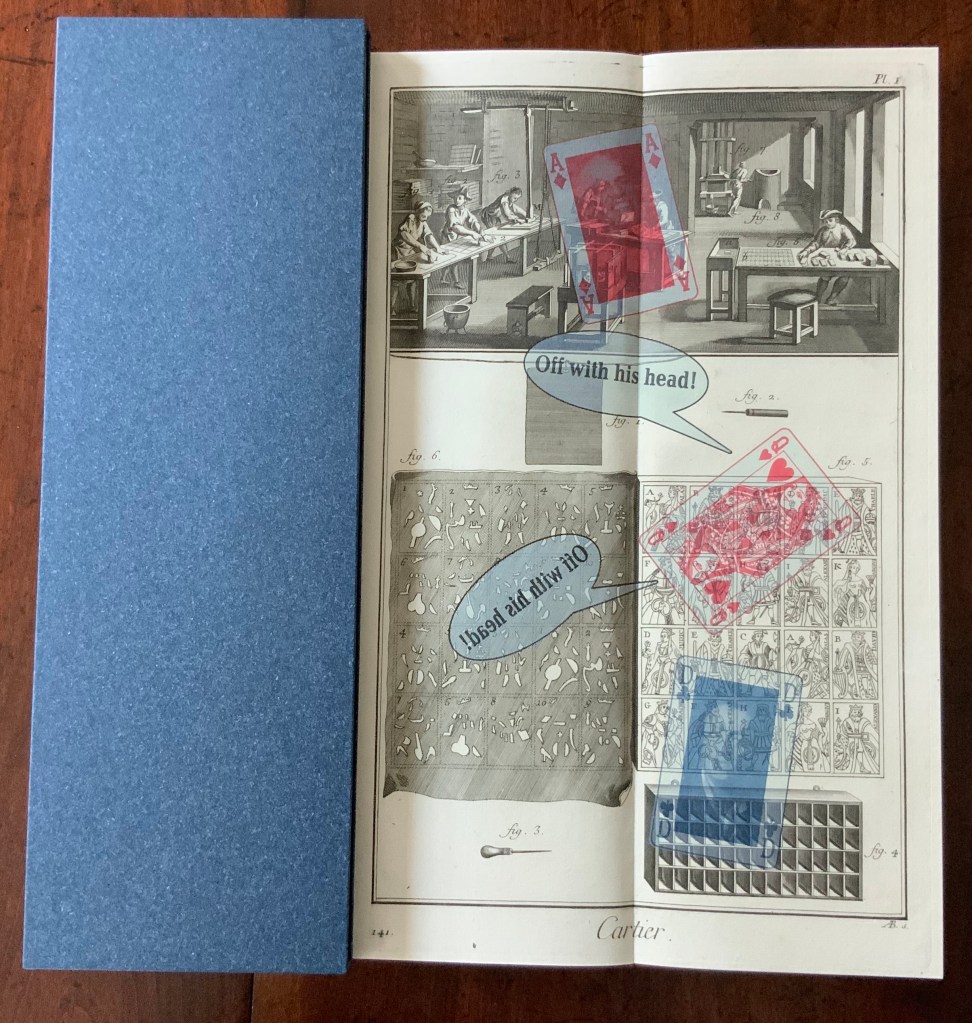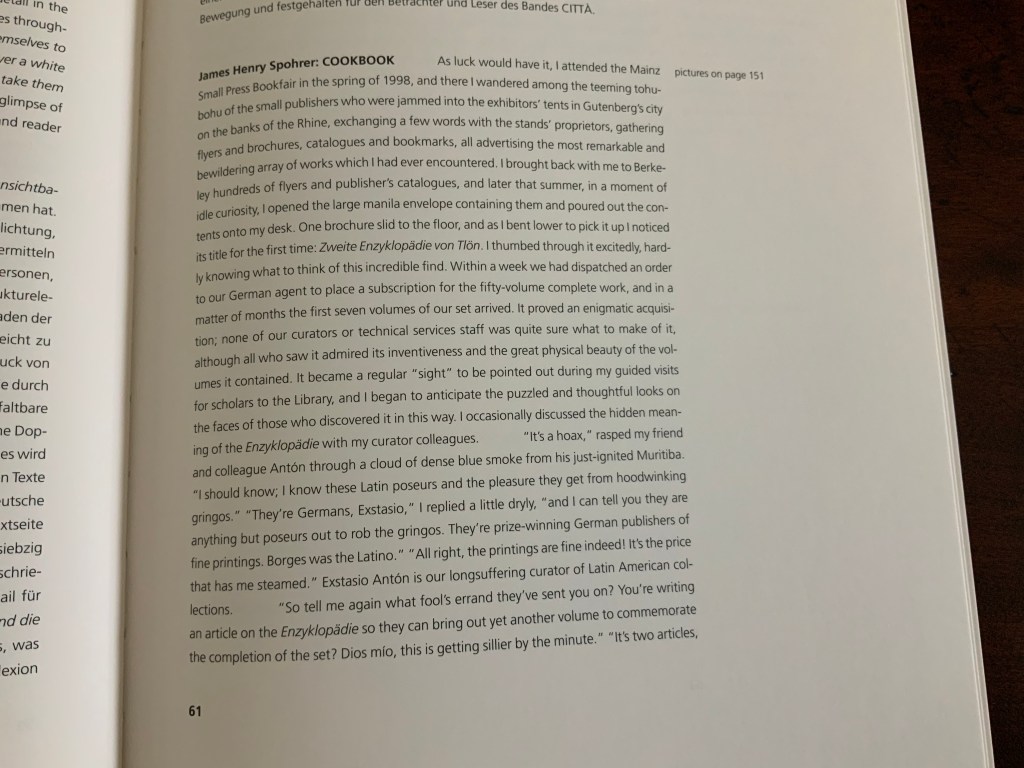Doctor Diderot’s & Mister d’Alembert’s Adventures in Wonderland & Through the Looking Glass (2018)

Doctor Diderot’s & Mister d’Alembert’s Adventures in Wonderland & Through the Looking Glass (2018)
Peter Malutzki
Book: H368 x W120 x D80 mm; Slipcase: H374 x W124 x D140 mm
Acquired from the artist, 10 February 2019
Malutzki’s tall small work evokes memories of Max Ernst’s Une Semaine de Bonté (1934) but pushes back on them with the work’s fine book execution. The book’s startling height derives from the more startling source of the paper: original pages from the plates volumes (1762-72) of Diderot’s Encyclopédie, ou dictionnaire raisonné des sciences, des arts et des métiers (1751-72). Through antiquarian dealers, Malutzki collected loose sheets from the first Paris folio edition and some from Italian editions (Lucca or Livorno).
The original engraving-papers (printed on one side as usual) are folded and glued together on the fore-edge. The stack of folded leafs has been glued at the spine with a small strip of glue so that each double spread has just a fold in the gutter, but no stitching, which shows the complete copper engraving unharmed structurally.
The endpapers are dyed through, and the fly-leaves are glued on the fore-edges to the first and last leaf of the book-block. The dark blue material used for the end-papers and the slipcase is an industrial one (Napura Khepera marine by Winter & Company) and is used for the endpapers. The Xian scarlet cloth for the cover also comes from Winter & Company. Throughout the book’s brief narrative, the dark blue associates with Diderot, and the scarlet with d’Alembert.


While Malutzki combines Ernst-like elements of the comic book and collage, the work is more of a conversation among imagery and concepts of the 18th, 19th and 20th centuries than an exercise in surrealism. It is a narrative built with the “pictures and conversations” that Alice finds lacking in the book her sister is reading by the river as Alice‘s Adventures in Wonderland (1865) opens. Malutzki piles this 19th century Victorian fantasy atop the 18th century by substituting the Enlightenment’s Encyclopédistes Doctor Diderot and Mister d’Alembert for Alice and her sister in the opening lines from Lewis Carroll’s story. The 20th century makes its appearance with the Playboy bunny in place of the White Rabbit and a clipart-like image of a book labelled “READ ME” in place of the bottle and cake labelled “DRINK ME” and “EAT ME”. The images in the 18th century engravings underlie the 19th century text in its speech bubbles. Nearly the only change to the text from Alice‘s Adventures in Wonderland and Through the Looking Glass (1871) is the substitution of the characters Diderot and d’Alembert for those in Carroll’s world.

In further allusion to Through the Looking Glass‘s mirror-world and upside-down logic, Malutzki has set some of the banderolle text in reverse and placed pairs of mirrored images crosswise — all overprinted on those 18th century engravings. Malutzki‘s precision and extensive experience with overprinting and the transparency of oil-based ink was essential given the limited supply of paper from the 250-year old volumes.
Inevitably, the collector has to confront the print preservationist’s question: how can you countenance the destruction of these 18th century prints? There is a several-fold unease. First, a worry for the security of such historical material (even altered) in the collection. Second, perhaps ironically, a worry over its preservation. And third, the worry whether the artistic quality of the work justifies the trade-off of the lost prints.
With at least a thousand complete sets of the original Encyclopédie (including the plates volumes) safely ensconced in academic and national libraries from France to Australia and still more loose prints (and sets) available from antiquarians, the use of these loose sheets for artistic purpose is lighter in the scales than the use of something far more rare or, worse, unique.
The preservationist might argue, “why not use the plates from one of the 20th century reprints?” Response: not the same tactility, not the same authenticity, not the same challenge or risk — not the same unease that prods the mind.
More directly to the artistic quality of Doctor Diderot’s and Mister d’Alembert’s Adventures: The photos here do little justice to the work’s precision, the sound of the slipcase’s snug fit, the layering of colours on the page, the motion of the spine, and the different textures of the 21st century cloth binding, the slipcase, endpapers and leaves of engraving papers so neatly adhering to each other that they feel like a single leaf. It is refreshing to see Alice appear outside the tableaux to which so many book artists have turned when inspired by Carroll. It is genius to have merged Carroll’s fictive exploration of logic and epistemology with the Enlightenment’s attempt to encompass humankind’s knowledge of the sciences, arts and industries or crafts.


Doctor Diderot’s and Mister d‘Alembert’s Adventures falls outside the span covered by Malutzki’s autobiography buchstäblich Buch (see under Further Reading). As such, it occupies a prospect from which to view Malutzki’s decades-long musing about the visual arts, knowledge and whimsy, all evident from his work — both solo and in collaboration with Ines von Ketelhodt — in the late 20th and early 21st centuries.
Zweite Enzyklopädie von Tlön: Ein Buchkunstprojekt von Ines von Ketelhodt und Peter Malutzki, 1997-2006 (2011)

Zweite Enzyklopädie von Tlön: Ein Buchkunstprojekt von Ines von Ketelhodt und Peter Małutzki, 1997-2006 (2011)
Ines von Ketelhodt and Peter Malutzki
H302 x W220 mm
256 pages; printed linen-over-board cover with embossed spine title, thread stitched; LuxoCream 115 gsm text paper; Frutiger, typeface.
Through his fiction — especially his story ”Tlön, Uqbar, Orbis Tertius” — Jorge Luis Borges has played as inspirational a role for artists and book artists as have Lewis Carroll, Stéphane Mallarmé and Laurence Sterne. An incomplete list includes Katie Holten’s About Trees, Sean Kernan’s Secret Books, Aurélie Noury‘s “Pierre Ménard, El Ingenioso hidalgo Don Quijote de la Mancha“, Hanna Piotrowska (Dyrcz)‘s Jorge Luis Borges, The Maker, Liliana Porter’s prints, Elaine Sturtevant’s Sturtevant: Author of the Quixote and Daniel Temkin’s and Rony Maltz’s Borges: The Complete Works. For book art, though, Malutzki’s and Von Ketelhodt’s fifty-volume work must lead the list, closely followed by this descriptive catalogue, a bookwork in itself.
Eva Hanebutt-Benz (Gutenberg-Museum Mainz) introduces the catalogue by defining the various sorts of encyclopedic reference work, where the Zweite Enzyklopädie fits in, how it is organised, and the inspirational role played by Borges’ story “Tlön, Uqbar, Orbis Tertius”, which is reproduced complete in the catalogue in Spanish as well as German and English. Hanebutt-Benz’s essay, too, is given first in German, then in English, establishing the pattern for all of the essays from the other twenty-two contributors to the catalogue — librarians, artists and curators — each describing two or more volumes of the Zweite Enzyklopädie.
This multilingualism of the catalogue is characteristic across the fifty volumes and the works of Von Ketelhodt and Malutzki in general. More important, by echoing the exploration of multilingualism, language and meaning in Borges’ story, it joins the story as a unifying force in the catalogue and across the Zweite Enzyklopädie. Excerpts from the story appear in many of the volumes, as the relevant contributors note and elucidate. Another unifying force aligned with the story is the artists’ use of the primary colours in the catalogue.






Sampling several paragraphs from the opening and closing of each language version, we can see the red, blue and yellow inks that are used to signal those portions of Borges’ text that appear somewhere in the fifty volumes. In the margins, the volume’s title and specific page number are called out in the relevant colour. The double-page spread separating the contributor’s essays from the section of photos of the fifty volumes applies the primary colours and black across the names of the fifty volumes, leaving space for future volumes. This is the sort of maker’s detail linked with the larger organisational elements that contributes to the unity of a work that, in Hanebutt-Benz’s words, is an “encyclopedic collection of creative possibilities, generating a book cosmos, closed within itself, playfully and yet following strict guide lines.”

As a work in and of itself, the catalogue intensifies so many of the characteristics of the more traditional “artist’s book” that, without the monolithic presence of the fifty volumes, sight of its “book art-ness” could slip away. The artists have a dual preventative. One is to make the fifty volumes a visible presence by giving each volume its own double-page spread following the double-page spread shown above. This generates 300 colour photos.
Another is a gamble: a roll of the dice that the twenty-three contributors would deliver comments on each volume that rise to the occasion. It was a winning gamble, but there is one superlative pair of essays that rings like a tuning fork: COOKBOOK and QUIZ as explained by librarian James Henry Spohrer (University of California, Berkeley). They are at once Borgesian, Malutzkian and Von Ketelhodt-esque.

Only the discussion of COOKBOOK is offered here — an incentive to visit QUIZ. In QUIZ, Spohrer seamlessly carries on his conversation with his “colleague“ Extasio Antón in a way that proves Hanebutt-Benz’s statement true:
The world recorded in this encyclopedia is, in the end, an actual encyclopedic collection of creative possibilities, generating a book cosmos, closed within itself, playfully and yet following strict guide lines.
Further Reading
“Ken Botnick“. 16 June 2022. Books On Books Collection. For another homage to Diderot.
“Lizzie Brewer“. 4 July 2023. Books On Books Collection. For another homage to Borges.
“Ines von Ketelhodt”, Books On Books Collection, 1 February 2021.
“Aurélie Noury“. 9 November 2020. Books On Books Collection. For another homage to Borges.
“Hanna Piotrowska (Dyrcz)“. 13 December 2019. Books On Books Collection. For another homage to Borges.
“Benjamin Shaykin“. 3 December 2022. Books On Books Collection. For another homage to Borges.
“Rachel Smith“. In progress. Books On Books Collection. For another homage to Borges.
Basile, Jonathan. 2015~. The Library of Babel. Website. Accessed 3 July 2023.
Hale, Julie and Beth Sweet. Masters: Book Arts – Major works by leading artists (New York: Lark Books, 2011).
Long, Elisabeth. “Even More Books from the Hybrid Book Fair”, The Sign of the Owl, 6 July 2009. Accessed 23 October 2019.
Long, Elisabeth. “Second Encyclopedia of Tlön”, The Sign of the Owl, 23 July 2009. Accessed 23 October 2019.
Mellby, Julie. “Zweite Enzyklopädie von Tlön”, Graphic Arts, Princeton University Library, 17 June 2010. Accessed 24 October 2019.
Soltek, Stefan. “Epilog” in buchstäblich Buch: eine Autobiographie by Peter Malutzki (Florsheim/Offenbach, Germany: Peter Małutzki/Klingspor Museum, 2017).








